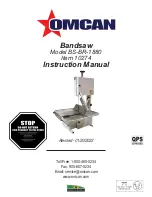
10
GB/IE
9.4 Adjusting the riving knife (fig. 9, 10)
m
WARNING:
Pull out the mains plug and wear protective gloves.
m
WARNING:
The setting of the saw blade (5) must be checked after every
saw blade replacement.
1. Remove the saw blade guard (4) (see 9.2.1).
2. Remove the table inlay (6) (see 9.3).
3. Set the saw blade (5) to the max. cutting depth (see 10.2).
4. Move the saw blade (5) to the 0° position and lock it in
place (see 10.3).
5. Loosen the fixing screws (33) on the riving knife.
6. Align the riving knife (3) such that
a) the distance between the saw blade (5) and the riving
knife (3) is max. 5 mm (fig. 10) and
b) the saw blade (5) is parallel to the riving knife (3).
7. Tighten the fixing screws (33) on the riving knife again.
8. Fit the table inlay (6) again (see 9.3).
9. Fit the saw blade guard (4) again (see 9.2.1).
9.5 Fitting/replacing the saw blade (fig. 11, 12)
m
WARNING:
Pull out the mains plug and wear protective gloves.
1. Set the saw blade (5) to the maximum cutting depth (see
10.2).
2. Undo the screws (34) of the bottom saw blade cover (35)
(fig. 11). Do not remove the screws completely.
3. Push the saw blade cover (35) upwards and open it.
4. Place a 19 mm ring spanner (21) on the nut. Hold against
the motor shaft with another 8 mm ring spanner (20) (fig.
12). To loosen, turn the nut in the rotation direction of the
saw blade.
5. Take off the outer flange and pull the old saw blade down
and off the inner flange at an angle.
6. Clean the saw blade flange carefully with a wire brush
before installing the new saw blade.
7. Put the new saw blade back in reverse order and tighten it.
m
WARNING:
Pay attention to the running direction. The cutting angle of
the teeth must point in the running direction, i.e. forwards
(see arrow on the saw blade cover (35) or the saw blade
guard (4)).
8. Close the lower saw blade cover (35) and re-tighten the
screws (34).
m
WARNING:
Check the protective devices before working with the saw
again.
9.6 Fitting the parallel stop (7) (fig. 2, 13-14)
1. Fasten the holder (16) to the table with the help of the lock-
ing screws (15) and the clamping plates (15a).
2. Make sure that the holder (16) is aligned parallel to the
saw blade (5). If necessary, readjust it with the aid of the
scales (38).
3. Fasten the stop rail (17) to the holder (16) with the help of
the screws (16a). Note the use of the stop rail (17) for thick
and thin workpieces (see 10.4)
9.7 Fitting the transverse stop (fig. 15)
As an alternative to the parallel stop (7), the transverse stop (2)
can be mounted:
1. Slide the transverse stop (2) into the groove (40) of the
saw table (1).
2. Loosen the turning handle (19).
3. Turn the transverse stop (2) until the arrow points to the
desired angle.
4. Tighten the turning handle (19) again.
5. Fasten the stop rail (17) with the help of the knurled screws
(18) on the transverse stop (2). Note the use of the stop rail
(17) for thick and thin workpieces (see 10.4)
9.8 Chip extraction (fig. 16)
ATTENTION:
Only operate the device with an extraction system.
Connect a suitable chip extraction system (not included in the
scope of delivery) to the extraction port (36).
A household vacuum cleaner is not suitable for use as an chip
extraction system.
ATTENTION:
Check and clean the extraction channels at regular intervals.
NOTE:
To use both extraction nozzles (36 and 4c) at the same time,
use the accessory extraction hose with T-adapter.
Article number: 7901301701 (not included in the scope of
delivery)
9.9 Stable fastening (fig. 17)
The machine must be securely installed, i.e. it must be bolted
down on a workbench, machine stand or similar, as shown in
fig. 17.
• Attach the two brackets for workbench mounting (42) to the
front of the machine. Therefore use the screws (43) and the
washers (44).
• Use the wood screws (45) to screw the machine on the work-
bench.
10. Handling
10.1 Switch (fig. 1)
10.1.1 On/off switch (11)
• It is possible to switch the saw on by pressing the green “I”
button. Before starting sawing, wait until the saw blade has
reached its maximum speed.
• In order to switch the saw off again, it is necessary to press
the red “0” button.
10.1.2 Overload switch (10)
In the event of overloading, the motor will switch itself off. After
a cool-down period (time varies) the motor can be switched
back on again.
















































